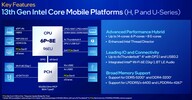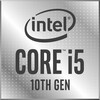Intel Core i5-1334U vs Intel Core i5-1035G1
Intel Core i5-1334U
► remove from comparison
The Intel Core i5-1334U is a mid-range mobile CPU for thin and light laptops based on the Alder Lake architecture (Raptor Lake-U / RPL-U series). It was announced in early 2023 and offers 2 performance cores (P-cores, Golden Cove architecture) and 8 efficient cores (E-cores, Gracemont architecture). The P-cores support Hyper-Threading leading to 12 supported threads when combined with the E-cores. The clock rate ranges from 1.3 to 4.6 GHz on the performance cluster and 0.9 to 3.4 GHz on the efficient cluster. The performance of the E-cores should be similar to old Skylake cores (compare to the Core i7-6700HQ). All cores can use up to 12 MB L3 cache. The CPU supports only "Essentials" vPro management features. Compared to the P-series (28W) or H-series (45W), the 15W TDP may limit the sustained performance.
Performance
Thanks to the similar clock speed, the Core i5-1334U is very similar to the older Core i7-1250U (+100 MHz P-Cores base clock rate). The faster i7 like the i7-1365U models offer only higher clock rates (and a faster iGPU). Compared to the similar i5-1335U, the 1334U only supports slower LPDDR5-5200 (vs 6400 of the faster models) and is therefore slightly slower.
Architecture
The integrated memory controller supports various memory types up to LPDDR5-5200. The Thread Director (in hardware) can support the operating system to decide which thread to use on the performance or efficient cores for the best performance. For AI tasks, the CPU also integrates GNA 3.0 and DL Boost (via AVX2). Quick Sync in version 8 is the same as in the Rocket Lake CPUs and supports MPEG-2, AVC, VC-1 decode, JPEG, VP8 decode, VP9, HEVC, and AV1 decode in hardware. The CPU still only supports PCIe 4.0 x8 for a GPU and two PCIe 4.0 x4 for SSDs.
The integrated graphics card is based on the Xe-architecture and offers 80 of the 96 EUs (Execution Units) operating at up to 1.25 GHz.
Power consumption
This Core i5 CPU is rated at a TDP of 15W (base power, PL1) and a maximum turbo power of 55W (PL2). The RPL-U processors are built in a further improved Intel 7 process (10nm SuperFin) that allows higher clock rates.
Intel Core i5-1035G1
► remove from comparison
The Intel Core i5-1035G1 is a low-power, Ice Lake family processor (SoC) featuring 4 cores, 8 threads, 6 MB of L3 cache and the UHD G1 (32 EUs) iGPU. It saw the light of day in H2 2019. The chip is designed for use in highly portable laptops; its CPU cores run at 1.0 GHz to 3.6 GHz, with only 3.2 GHz achievable if all the cores are loaded.
Unlike the costlier Core i5-1035G4, the 1035G1 has the 32 EU UHD Graphics G1 iGPU at its disposal as opposed to the more powerful 48 EU Iris Plus G4; CPU cores run at a slightly lower clock rate in the case of the 1035G1, too.
Architecture & Features
Ice Lake family chips are powered by Sunny Cove CPU cores.The latter aim to do what Palm Cove cores (that we never really got a chance to get a taste of) were expected to do, delivering a double-digit IPC uplift over the venerable Skylake architecture thanks to a range of small improvements across the board including scheduler improvements, larger caches and buffers, and support for new instruction sets.
Thunderbolt 3 support is built right into the Core i5 (meaning the latter has several PCIe 3 lanes exclusive to Thunderbolt devices, reducing the number of additional components required for Thunderbolt to work) and so is Intel CNVi Wi-Fi 6 support (making it easier for Intel to sell its proprietary WLAN cards to laptop makers). The Core i5-1035G1 also has the DL Boost and GNA features for applications centered around machine learning.
The 4 GT/s bus is indicative of a consumer-grade chip, since CPUs for gaming laptops and portable workstations usually employ the faster 8 GT/s bus. RAM support is nothing to sneeze at, at up to DDR4-3200 or LPDDR4-3733. NVMe SSDs are supported, with data transfer rates limited to 3.9 GB/s (this is what four PCIe 3 lanes are good for). SATA drives and even eMMC chips are also natively supported here.
This is not a user-replaceable CPU, as it gets permanently soldered to the motherboard (BGA1526 socket interface).
OS support is limited to 64-bit Windows 10 and Windows 11, as well as many Linux distros.
Performance
The Core i5-1035G1 is a lower mid-range CPU, as of mid 2022. It is good for more than just the basics while being no match for true high-performers such as the mighty Core i7-10850H.
According to our in-house testing, the Core i5 delivers multi-thread performance that is similar to what the Core i7-10610U, the Core i7-1160G7 and the Ryzen 5 PRO 3500U have to offer. Your mileage may vary depending on how competent the cooling solution of your system is and how high the CPU power limits are.
The Lenovo IdeaPad 5 15IIL05 is among the fastest laptops featuring the 1035G1 that we have tested.
Graphics
The UHD Graphics G1 is based on Intel's Gen 11 architecture. The UHD Graphics runs at up to 1,050 MHz and has 32 EUs for fairly unimpressive performance; the Iris Plus G4 has 48 EUs while the Iris Plus G7 has 64 EUs, for reference. This iGPU will drive up to 3 monitors simultaneously and is DX12-compatible. The resolution options are capped at 5120 by 3200. There is no hardware AV1 codec support here, meaning such a video will be SW-decoded with rather low energy efficiency. The usual HEVC, AVC and VP9 codecs are supported, thankfully.
The UHD Graphics is significantly faster than the UHD Graphics 620, yet it's still not as good as a proper discrete graphics card would be. It will let one play certain games, F1 2020 included, provided one is content with the 720p resolution and low quality settings.
Power consumption
The Core i5-1035G1 has a default TDP (also known as the long-term Power Limit) of 15 W. Laptop makers are free to increase that value somewhat, with 25 W being the upper limit, or reduce it (values as low as 13 W are possible). Clock speeds and performance will change accordingly as a result. Either way, an active cooling solution will be required to dissipate the heat.
The chip is manufactured on Intel's second-generation 10 nm process (not "10 nm SuperFin" or "Intel 7") for average, as of late 2022, energy efficiency.
| Model | Intel Core i5-1334U | Intel Core i5-1035G1 | ||||||||||||||||||||||||||||||||||||||||||||||||||||||||
| Codename | Raptor Lake-U | Ice Lake-U | ||||||||||||||||||||||||||||||||||||||||||||||||||||||||
| Series | Intel Raptor Lake-U | Intel Ice Lake | ||||||||||||||||||||||||||||||||||||||||||||||||||||||||
| Series: Ice Lake Ice Lake-U |
|
| ||||||||||||||||||||||||||||||||||||||||||||||||||||||||
| Clock | 900 - 4600 MHz | 1000 - 3600 MHz | ||||||||||||||||||||||||||||||||||||||||||||||||||||||||
| L1 Cache | 928 KB | 192 KB | ||||||||||||||||||||||||||||||||||||||||||||||||||||||||
| L2 Cache | 9.5 MB | 2 MB | ||||||||||||||||||||||||||||||||||||||||||||||||||||||||
| L3 Cache | 12 MB | 6 MB | ||||||||||||||||||||||||||||||||||||||||||||||||||||||||
| Cores / Threads | 10 / 12 | 4 / 8 | ||||||||||||||||||||||||||||||||||||||||||||||||||||||||
| TDP | 15 Watt | 15 Watt | ||||||||||||||||||||||||||||||||||||||||||||||||||||||||
| Technology | 10 nm | 10 nm | ||||||||||||||||||||||||||||||||||||||||||||||||||||||||
| max. Temp. | 100 °C | 100 °C | ||||||||||||||||||||||||||||||||||||||||||||||||||||||||
| Socket | BGA1700 | BGA1526 | ||||||||||||||||||||||||||||||||||||||||||||||||||||||||
| Features | Thread Director | DDR4-3200/LPDDR4-3733 RAM, PCIe 3, 4 GT/s bus, DL Boost, GNA, MMX, SSE, SSE2, SSE3, SSSE3, SSE4.1, SSE4.2, AVX, AVX2, AVX-512, BMI2, ABM, FMA, ADX, VMX, SMEP, SMAP, EIST, TM1, TM2, Hyper-Threading, Turbo, SST, AES-NI, RDRAND, RDSEED, SHA, SGX | ||||||||||||||||||||||||||||||||||||||||||||||||||||||||
| iGPU | Intel Iris Xe Graphics G7 80EUs ( - 1250 MHz) | Intel UHD Graphics G1 (Ice Lake 32 EU) (300 - 1050 MHz) | ||||||||||||||||||||||||||||||||||||||||||||||||||||||||
| Architecture | x86 | x86 | ||||||||||||||||||||||||||||||||||||||||||||||||||||||||
| Announced | ||||||||||||||||||||||||||||||||||||||||||||||||||||||||||
| Manufacturer | www.intel.com | ark.intel.com |
Benchmarks
Average Benchmarks Intel Core i5-1334U → 100% n=2
Average Benchmarks Intel Core i5-1035G1 → 70% n=2
* Smaller numbers mean a higher performance
1 This benchmark is not used for the average calculation












